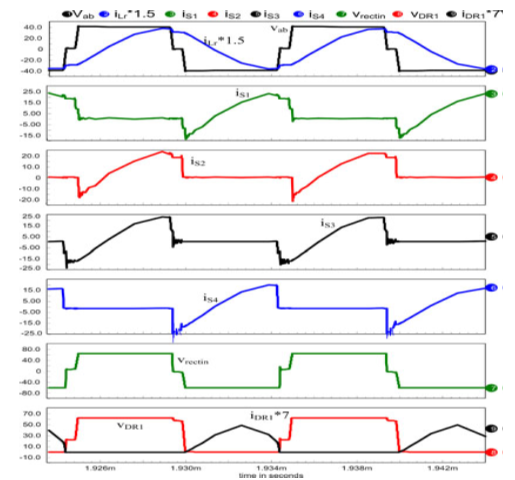FLC-Based
DTC Scheme to Improve the
Dynamic Performance of an IM Drive
ABSTRACT:
This paper presents a fuzzy logic hysteresis comparator-based
direct torque control (DTC) scheme of an induction motor (IM) under varying
dynamic conditions. The fuzzy logic controller (FLC) is used to adjust the
bandwidth of the torque hysteresis controller in order to reduce the torque and
flux ripples and, hence, to improve motor dynamic response. The effects of
torque hysteresis bandwidth on the amplitude of torque ripples of an IM are
also discussed in this paper. Based on the slopes of motor-estimated torque and
stator current, an FLC is designed to select the optimum bandwidth of the
torque hysteresis controller. This paper also proposes a simpler algorithm than
the conventional trigonometric function-based algorithm to evaluate the sector
number (required for DTC scheme) of the stator flux-linkage space vector. The
proposed algorithm reduces the computational burden on the microprocessor. In
order to test the performance of the proposed FLC-based DTC scheme for IM drive,
a complete simulation model is developed using MATLAB/ Simulink. The proposed
FLC-based DTC scheme is also implemented in real time using DSP board DS1104
for a prototype 1/3 hp motor. The performance of the proposed drive is tested
in both simulation and experiment.
KEYWORDS:
1 Direct
torque control (DTC)
2 Field-oriented
control(FOC)
3 Fuzzy
logic controller (FLC)
4 Induction
motor (IM)
5 Torque and flux hysteresis controllers
6 Torque ripples
SOFTWARE:
MATLAB/SIMULINK
CONVENTIONAL BLOCK DIAGRAM:
Fig.
1. Conventional DTC scheme for IM drive.
SIMULATION
RESULTS:
Fig. 2. Steady-state speed responses of the
IM drive for a step change in load from 0.3 to 0.8 N · m at 120 rad/s. (a) Conventional DTC. (b)
FLC-based DTC.
Fig. 3. Developed torque responses of the IM
drive for a step change in load from 0.3 to 0.8 N · m at speed of 120 rad/s. (a) Conventional
DTC. (b) FLC-based DTC scheme.
Fig. 4. Developed torque of the IM drive at
40% of rated load. The step change in speed from 100 to 150 rad/s is applied at
0.15 s. (a) Conventional DTC. (b) FLC-based DTC scheme.
Fig. 5. Steady-state stator flux-linkage
responses of the IM drive, at 40% rated load and speed of 120 rad/s. (a)
Conventional DTC. (b) Proposed FLCbased DTC scheme.
Fig. 6. Steady-state stator current response
of the IM drive at 40% rated load and speed of 120 rad/s. (a) Conventional DTC.
(b) FLC-based DTC scheme.
CONCLUSION:
A
novel FLC-based DTC scheme for IM drive has been presented in this paper. The
proposed FLC-based IM drive has been successfully implemented in real time
using DSP board DS1104 for a laboratory 1/3 hp IM. The FLC is used to adapt the
bandwidth of the torque hysteresis controller in order to reduce the torque
ripple of the motor. A performance comparison of the proposed FLC-based DTC
scheme with a conventional DTC scheme has also been provided both in simulation
and experiment. Comparative results show that the torque ripple of the proposed
drive has considerably been reduced. The dynamic speed response of the proposed
FLC-based DTC scheme has also been found better as compared to the conventional
DTC scheme.
REFERENCES:
[1]
I. Takahashi and T. Nouguchi, “A new quick response and high efficiency control
strategy for an induction motor,” IEEE Trans. Ind. Appl., vol. IA- 22,
no. 5, pp. 820–827, Sep. 1986.
[2]
L. Tang, L. Zhong, M. F. Rahman, and Y. Hu, “A novel direct torque control for
interior permanent-magnet synchronous machine drive with low ripple in torque
and flux-a speed-sensorless approach,” IEEE Trans. Ind. Appl.,
vol. 39, no. 6, pp. 1748–1756, Sep./Oct. 2003.
[3]
S. Kouro, R. Bernal, H. Miranda, C. A. Silva, and J. Rodriguez,
“Highperformance torque and flux control for multilevel inverter fed induction motors,”
IEEE Trans. Power Electron., vol. 22, no. 6, pp. 2116–2123, Nov. 2007.
[4]
D. Casadei and T. Angelo, “Implementation of a direct torque control algorithm for
induction motors based on discrete space vector modulation,” IEEE Trans. Power
Electron., vol. 15, no. 4, pp. 769–777, July 2000.
[5]
C.-T. Lin and C. S. G. Lee, Neural Fuzzy Systems: A Neuro-Fuzzy Synergism to
Intelligent Systems. Upper Saddle River, NJ: Prentice-Hall, 1996.


























